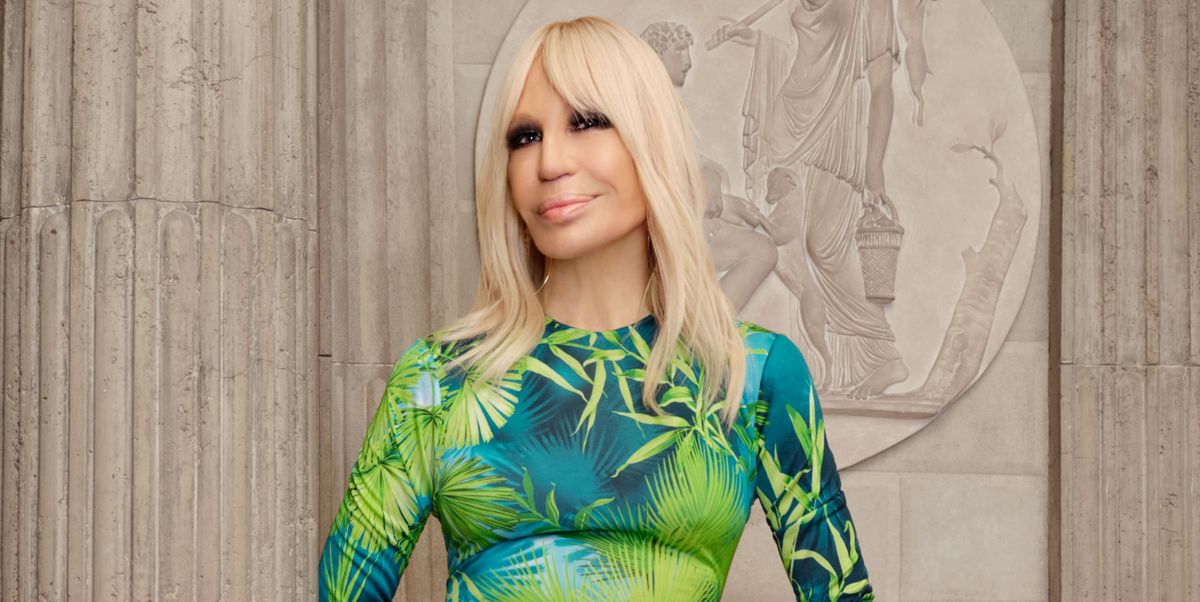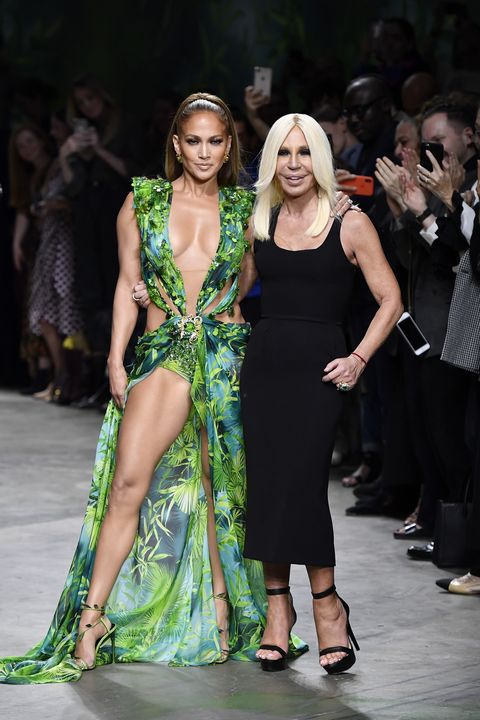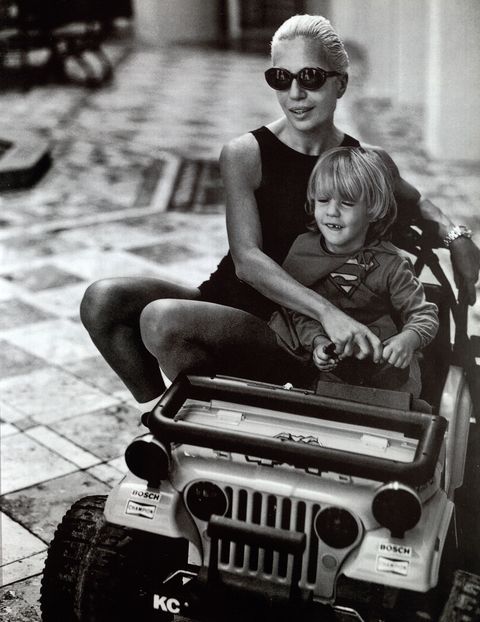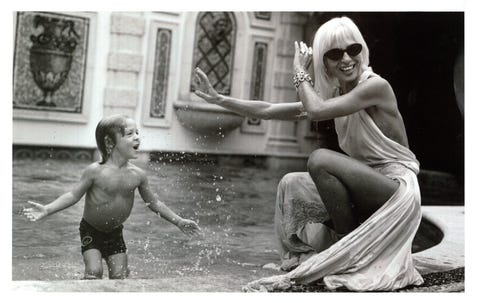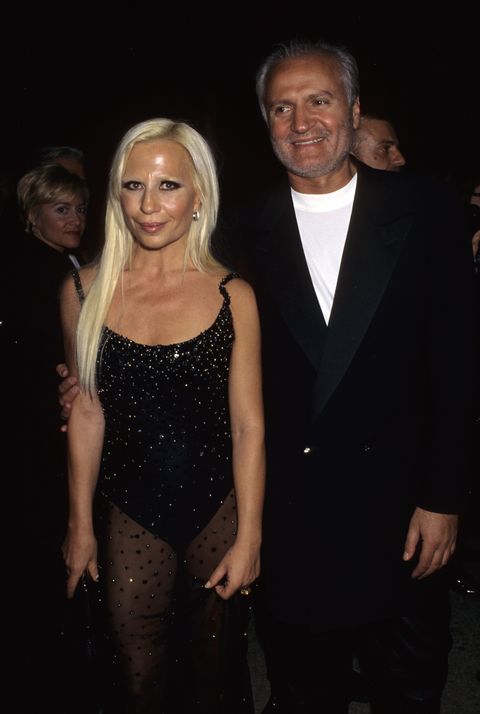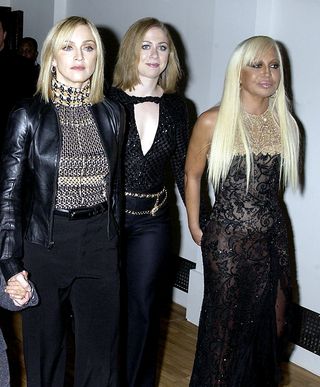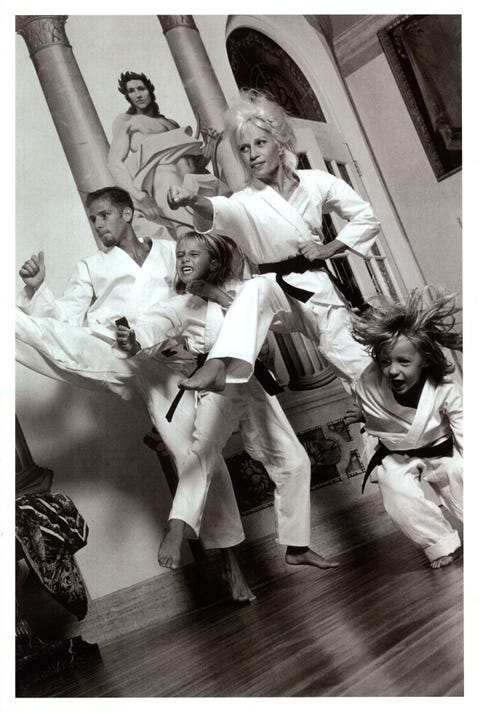Shortly before I interview Donatella Versace, I ask my colorist to bump up my already-straining-credulity blond by a shade. That’s the effect Versace has on you before you even meet her: Some people make you stand up straighter in their presence; she has a way of drawing out your inner Italian bombshell. In a world taken over by penitent Marie Kondo–style bloodletting of our gladdest glad rags, she is a beacon of maximalism, an old-school practitioner of Fashion with a capital F, a full-throated defender of glamour. And isn’t that refreshing? Today, when so much high fashion looks like what you’d wear at a particularly progressive convent, when we’re apparently expected to don outfits that resemble scaffolding on a Brutalist building, don’t you want to be a little sexier? Flashier? Versace-er?
J.Lo definitely does. For the house’s spring 2020 show, she re-wore her 2000 Grammys look, a jungle-print dress that didn’t so much break the internet as remake it, spurring Google to create its image-search function. With her bronzed, toned body and her confident strut, J.Lo, if I may, made that dress her bitch. And the audience raised thousands of iPhones in tribute. “There was so much energy in the room, and you could feel the power of us creating a special moment in time,” Lopez says. “The power of women behind it, the power of fashion behind it, the power of putting beautiful things out into the world and celebrating beautiful moments in life—that’s what it was.”
Or in Versace’s own summary of that moment: “I’m here. Look at me: I’m not afraid, I’m not 20 years old, but I’m much better.” That’s the kind of empowerment Donatella Versace stands for. Not necessarily the bland boardroom, PowerPoint connotation of the word, but the ability to say, “Hey, world: I’m 50, I’m fabulous, and I’m here.”
Versace’s kingdom, I’d hazard to guess, has room for the inner circle of fashion Illuminati and the people who, like Elizabeth Berkley’s character in the seminal Showgirls, pronounce it Versayce. She’s a big-tent kind of girl. And she has a self-professed knack for spotting people on their way up. “You have to have an eye to see behind the way they look. I look for what they represent,” she says, offering Gigi Hadid, who has walked many of her shows and starred in several Versace ad campaigns, as an example. “I met Gigi when she was 16, and she was gorgeous, of course, but she wasn’t a typical model at that moment. But there was something there: a kindness, a tenderness, the beauty inside, not just outside. One of her first fashion shows was for me.”
So many designers start out modestly—the perfect white shirt, the perfect little black dress, a wide tie—and build from there. When Gianni Versace founded the house that would bear his name, he was already thinking in epic terms, doing what a science fiction author would call “world-building.” Growing up in Calabria, Italy, a former Greek colony that retained its classical motifs as well as its Roman glory, he drew on the might and myth of those traditions. He would make the Medusa his logo, and dress his “girls” like some combination of (sex) goddess and gladiator. Donatella was his muse and right hand—he dedicated his perfume Blonde to her.
The vision has only gotten bigger. Now you can stay in a Versace hotel; lounge in a logo bathrobe with a Barocco-printed belt and matching slippers (next to Fido in his coordinating dog bed); and, if your vice decrees, flick cigarette ash into a Medusa-head ashtray. They’ve truly thought of everything.
The brand is larger than life, and so is its current figurehead. Given the way she looms over our culture—there are few designers well-known enough to be identifiable by a first name, let alone a Saturday Night Live impression—it was hard to believe the received wisdom that Donatella Versace is shy. (“That’s the most uncomfortable thing for me,” she’ll later tell me, of her own celebrity.) But it’s true. She is soft-spoken, small-wristed, elfin.
When we meet, it’s hard to put this petite woman in the context of the sprawling hotel penthouse she’s sitting in, let alone the massive international brand she sits at the helm of. Her voice is subdued, the discreet growl of a domesticated tiger. She excitedly talks about her recent pilgrimage to see the Downton Abbey movie. (Imagine Donatella Versace at the ticket counter saying, “One for Downton Abbey, please.” Just sit with that image for a moment. Consider it my gift to you.) I like the Crawleys as much as anyone, but none of this jibes with my conception of Milanese excess. Where are the gold Medusas? The gold safety pins? The…other gold things? But then I ask for tea, and it’s conveyed to me in a gilded Versace cup with a winged handle, and I’m officially whisked off to Versace-land.
So I say hello to the woman behind the curtain of pin-straight platinum-blond hair and the daytime smoky eye—who, it seems, actually is deeply introverted. At least, according to the woman herself. She conceived the look as armor, “so people would talk about how I look, not about what I have inside.” There were, she says, “things happening in my life, and I didn’t want to explain.” She retreated even further into the image during the most difficult season of her life, Gianni’s 1997 murder, which thrust her into the spotlight as she took over the brand. (Her brother is never far from her mind; her spring 2018 collection was a tribute to him on the twentieth anniversary of his passing, and today she’s wearing a navy sweater imprinted with his signature.)
She developed a tough outer shell as a coping mechanism—not just the hair and makeup, but the whole package. At one point, she kept the same trainer for 18 years. She imitates herself whining, not wanting to do another rep: “He didn’t listen to anything I say! I love that.” But despite her protestations, fitness gave her discipline and mental clarity. Ever image-conscious, she would even bring the trainer on vacation with her.
Recently, though, she’s felt more comfortable being herself. On Instagram, she kicked back in a pair of novelty turkey slippers (Caption: “You see…I don’t always wear high heels!!”), and she made a cameo appearance in a campy soap opera for the brand’s holiday campaign. You might say she’s embracing her extra-ness. “Toned-down, that’s not me,” she shrugs. “Take it or leave it.”
She contributed to the rise of the supermodel, hardly a toned-down creature. Long before Gigi was a glimmer in Yolanda’s eye, models were sharply divided into “print” and “runway” girls, but Donatella chafed against the distinction. “I brought them to Milan, and Gianni was like”—she imitates their easy sibling back-and-forth—“She can’t walk.”
“Doesn’t matter.”
“She’s not tall enough.”
“Doesn’t matter. Put that dress on her; you’ll see that she’s going to be tall enough.”
When I mention the period in the mid-’90s when designers opted for scores of anonymous, interchangeable models, she sputters, “Oh God, I couldn’t take it anymore!” The Versace girl has always been a supermodel. For the house’s fall 1991 show, a band of mononymic glamazons—Linda, Cindy, Naomi, Christy—strutted to the strains of George Michael’s “Freedom! ’90” (a watershed moment Versace nodded to more than 25 years later by reuniting some of those supermodels at her spring 2018 show). Versace was prescient, about that and other things, too. She foresaw the friends-with-benefits relationship that would spring up between pop music and fashion, forging early alliances with Madonna and Prince; the latter made CDs of then-unreleased music especially for the Atelier Versace couture show in 1995. “This kind of clash of culture, it was very interesting to me,” she says. “And I thought, ‘Fashion, if it doesn’t go into this world, it will become irrelevant.’ ” And before politicians and fashion mingled so seamlessly, she invited Chelsea Clinton to her spring 2002 fashion show and gave her a mini-Donatella makeover. (“I saw her recently. I adore her. She’s a smart girl,” she says of Clinton.)
Her interest in politics hasn’t abated. She imitates her phone, going, going, going with its fusillade of push notifications. Her morning news-gathering routine goes like this: Politics first. “And then fashion, and then music, and then art.” She has a lot to say about, for example, Greta Thunberg. (“I’m very happy a 16-year-old girl said, ‘How dare you take my future away?’ I really like the youth in this moment; there are a lot of young people with great ideas.”) They remind her of her student days at the University of Florence: “I was into protesting. I was outside in the street.”
She’s also been outspoken regarding the #MeToo movement. (“I’ve always defended women. I’m finding a lot of women more interesting than men right now.”) While she says she didn’t face sexism when assuming her mantle at the company, she acknowledges that this is probably because “I was in a [more] privileged position” as a family member. When I mention the wave of covered-up fashions that followed in the wake of the #MeToo allegations, she purrs, “Not on my runway.” She’s a firm believer that a woman should be able to dress however she likes. She wants to live in a world where you can command the C-suite in a corset. And why not?
Versace is an ardent supporter of LGBTQ rights; because of her brother’s legacy, she says, “I can’t not be.” Last year, she was named a Stonewall Ambassador, making the scene at New York City’s Pride March in a rainbow-sequined dress and matching go-go boots. We commiserate for a bit about the rollback of LGBTQ rights in the United States. “I wish people would fight more. People fight in New York, people fight in L.A., but the other places in America, they need help,” she says. “They need to be pushed to fight, because this is not right. The country is not moving forward. It’s going backward.”
One thing that is going forward, in a big way, is the house of Versace. In 2018, the company was acquired by luxury group Capri Holdings, also the parent company of Michael Kors and Jimmy Choo. “I was very careful about deciding something like this, which could change my life completely,” Versace says of the sale. “I think the company needs to move ahead. I’m very happy about my choice, because Versace can grow faster.”
Indeed, Capri is pursuing an aggressive expansion of the brand, with plans to open dozens of stores each year. Beyond that, she doesn’t know what the future holds. “I cannot live forever, I’m not gonna be here forever, and things change in fashion. I’m the first one open to changes.” But there are none on the horizon just now. She jokes, “Nobody wants me to step aside, and that’s terrible!”
Instead, she’s gone full bore on aligning the brand with her beliefs. Versace ceased using fur in 2018, and the company is striving to be more sustainable, having just opened a new green headquarters in Milan constructed from ethically sourced materials. As they’re opening all those new stores, they’re asking all the nitty-gritty questions. “Where do you source the materials? How do you recycle the water?” she says. “How can you use less electricity? All of these aspects are taken into consideration now.” She’s also taking steps in her own life. This famous jet-setter? She says she’s no longer flying private.
And when it comes to her designs, she sees quality and craftsmanship as the antidote to the fast-fashion mind-set. “We cannot forget the value of heritage, because today fashion is like, ‘Wear today; throw it away tomorrow,’ ” she says. It’s rare to see someone who’s so squarely a part of the old-school fashion world and yet so engaged with everything new. She says she keeps herself surrounded with young, creative employees, a posse of anti–yes men and women. “It’s so easy to surround yourself with people who think like you, who say yes [to everything]. That’s the moment you should retire. You should go do something else.”
This article appears in the March 2020 issue of ELLE.
